Georgia – Kartli Shida/Kvemo, Mtskheta, Kakheti (Tbilisi, Gori) November 20-23, 2019
GORI
Stalin House and Museum. Now in a park, Stalin’s birth house is housed under a monumental stone canopy. The tiny, flat roofed, brick house had 2 rooms, one for the landlord and one for Stalin and his family. They lived here for 4 years from 1900-04). 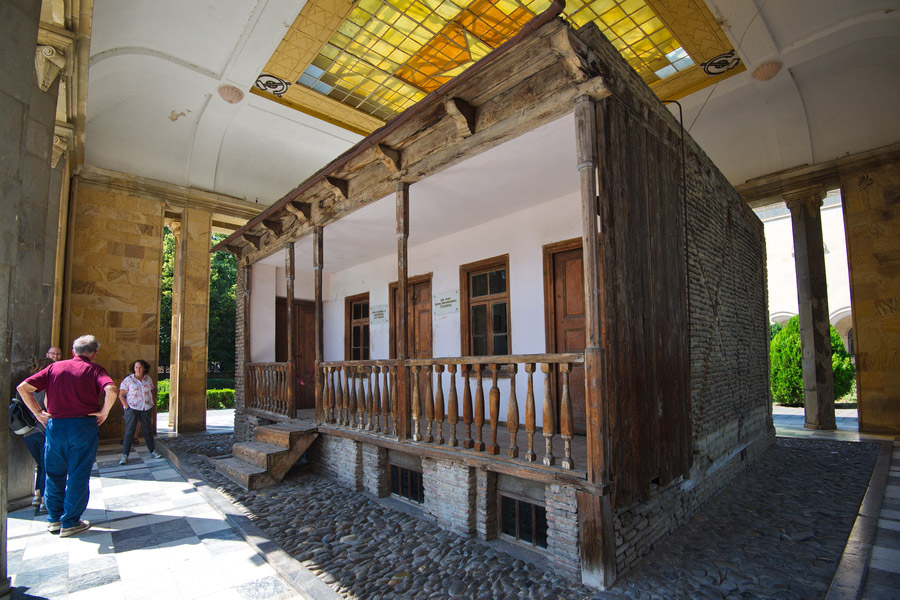
The large 2-story stone museum sits behind the house. Mostly in Russian and Georgian, there was not much of interest. Try to join the English tour to get more out of the visit. His private railway car sits next to the museum. It is not overly opulent. GEL15
Joseph Stalin (1878-1953) was a Georgian revolutionary and Soviet politician who led the Soviet Union from the mid–1920s until 1953 as General Secretary of the Communist Party of the Soviet Union (1922–1952) and Premier (1941–1953). Despite initially governing the Soviet Union as part of a collective leadership, he eventually consolidated power to become the country’s de facto dictator by the 1930s. A communist ideologically committed to the Leninist interpretation of Marxism, Stalin formalised these ideas as Marxism–Leninism, while his own policies are known as Stalinism.
Born to a poor family in Gori in the Russian Empire (now Georgia), Stalin joined the Marxist Russian Social Democratic Labour Party as a youth. He edited the party’s newspaper, Pravda, and raised funds for Vladimir Lenin’s Bolshevik faction via robberies, kidnappings, and protection rackets. Repeatedly arrested, he underwent several internal exiles. After the Bolsheviks seized power during the 1917 October Revolution and created a one-party state under Lenin’s newly renamed Communist Party, Stalin joined its governing Politburo. Serving in the Russian Civil War before overseeing the Soviet Union’s establishment in 1922, Stalin assumed leadership over the country following Lenin’s 1924 death. Under Stalin, “Socialism in One Country” became a central tenet of the party’s dogma. Through the Five-Year Plans, the country underwent agricultural collectivisation and rapid industrialisation, creating a centralised command economy. This led to significant disruptions in food production that contributed to the famine of 1932–33. To eradicate accused “enemies of the working class”, Stalin instituted the “Great Purge”, in which over a million were imprisoned and at least 700,000 executed between 1934 and 1939. By 1937, he had complete personal control over the party and state.
Stalin’s government promoted Marxism–Leninism abroad through the Communist International and supported European anti-fascist movements during the 1930s, particularly in the Spanish Civil War. In 1939, it signed a non-aggression pact with Nazi Germany, resulting in the Soviet invasion of Poland. Germany ended the pact by invading the Soviet Union in 1941. Despite initial setbacks, the Soviet Red Army repelled the German incursion and captured Berlin in 1945, ending World War II in Europe. The Soviets annexed the Baltic states and helped establish Soviet-aligned governments throughout Central and Eastern Europe, China, and North Korea. The Soviet Union and the United States emerged from the war as global superpowers. Tensions arose between the Soviet-backed Eastern Bloc and U.S.-backed Western Bloc which became known as the Cold War. Stalin led his country through the post-war reconstruction, during which it developed a nuclear weapon in 1949. In these years, the country experienced another major famine and an anti-semitic campaign peaking in the doctors’ plot. After Stalin’s death in 1953 he was eventually succeeded by Nikita Khrushchev, who denounced his predecessor and initiated the de-Stalinisation of Soviet society.
Widely considered one of the 20th century’s most significant figures, Stalin was the subject of a pervasive personality cult within the international Marxist–Leninist movement which revered him as a champion of the working class and socialism. Since the dissolution of the Soviet Union in 1991, Stalin has retained popularity in Russia and Georgia as a victorious wartime leader who established the Soviet Union as a major world power. Conversely, his totalitarian government has been widely condemned for overseeing mass repressions, ethnic cleansing, deportations, hundreds of thousands of executions, and famines which killed millions.
Gori Fortress. This fortress sits on a high hill overlooking the city from the west.
Uplistsikhe Cave Town. A tentative WHS (24/10/2007), this rock-cut city was one of the oldest urban centers in the Caucasus. The earliest caves date from the 10th century BC, but most were cut in the sandstone in the Classical period. It was the major religious, political and communal center of the east Georgian kingdom of Kartli (Iberia) during Hellenistic (3rd-1st centuries BC) and Roman (1st-3rd centuries AD) times. It was finally abandoned after the 13th and 14th century Mongol raids. It became a reserve in 1948.
Climb up115 steps though a marvelous rock-cut tunnel to the caves that climb the hill. There are defensive walls, a ditch, streets, water pipes, many meter wide cut holes, wells, a theatre, temple pit for sacrifices and on the top if the hill, the Uplistsikhe Church, a single nave brick basilica dating from the 2nd half of the 10th century.
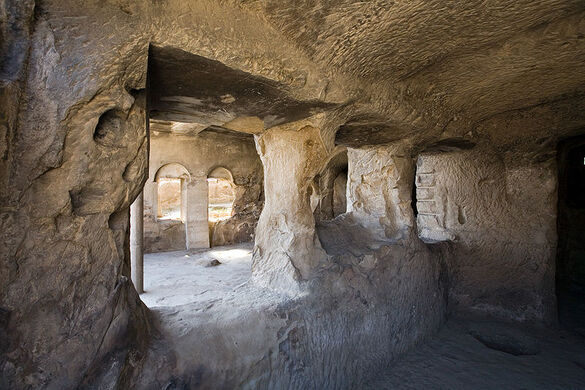
Samtavisi Cathedral. A tentative WHS (24/10/2007). This eleventh-century Georgian Orthodox cathedral is 45km from Tbilisi. It is the founder of the Georgian interpretation of the cross-in-square churches. The Cathedral was heavily damaged by a series of earthquakes and was first partially reconstructed in the 15th-16th century and again in the 19th century. The masterly decorated eastern façade with a bold ornate cross motif, is the only surviving original structure.
In contrast to earlier Georgian churches, the drum of the dome is taller surmounted by a conical roof. The original frescoes of the 11th century, found under the apse plaster, are rather fragmentary. The 17th century frescoes, less monumental and less detailed than the earlier, remain only in the dome and the apse. Dominant colors are dark brown, blue, yellow and dark grey.
Heavily fortified surrounded by a 5m wall with several ruined towers, enter through the bell tower gate.
Palace of Mukhrani. Mukhrani. Part of Kartli, the main building was designed in 1873 for Prince Ivane Bagration of Mukhrani and construction took 12 years. The gardener was invited from the Palace of Versailles. The Mukhrani residence was an important cultural and political center for the Georgian elite of the Belle Époque. It was renovated in 2012 and now belongs to the “Château Mukhrani” wine company.
MTSKHETA
Mtskheta is one of the oldest cities of Georgia and its former capital, it is located approximately 20kms north of Tbilisi set on a lowland, surrounded by mountains, at the confluence of the two rivers, Mtkvari and Aragvi. The city is approached from
the north by the Greater Caucasus and from the south by the Lesser Caucasus mountains.
Currently a small provincial capital, for nearly a millennium until the 5th century AD, Mtskheta was large fortified city, a significant economical and political centre of the Kingdom of Iberia.
Due to its historical significance and several cultural monuments, the “Historical Monuments of Mtskheta” became a UNESCO World Heritage Site in 1994. As the birthplace and one of the most vibrant centers of Christianity in Georgia, Mtskheta was declared as the “Holy City” by the Georgian Orthodox Church in 2014.
HISTORY
Foundation. Mtskheta was founded by the ancient Meschian tribes in the 5th century BC.
Capital of the Kingdom of Iberia. Mtskheta was the capital of the early Georgian Kingdom of Iberia from the 3rd century BC to the 5th century AD. The chronicles mention that the Kingdom of Iberia and its capital were conquered by Alexander the Great in the 4th century BC, but certain historians do not accept this. Eventually, the ruler appointed by Alexander ruined the walls of Mtskheta and left only four fortresses, one of them known today as Armazi.
A new wall around Mtskheta was built by the first Georgian King Parnavaz in the beginning of the 3rd century BC, and later strengthened in the late 3rd and 1st century BC, and later also by Aderki. Pharasmanes I is associated with appearance of first Christian communities in Kartli and arrival of the Holy Tunic to Mtskheta, brought from Jerusalem by local Jews.
The city was strongly fortified at that period. Walls were on both sides of Mtkvari River, and three forts were protecting it. The main citadel, Armazi, on Mount Bagineti was controlling the entrance from south and east, Tsitsamuri, at the base of Mount Jvari from the north, and Sarkine from the west.
Mtskheta was a site of early Christian activity resulting in Christianization of Iberia, where Christianity was proclaimed the state religion in 337. It remains the headquarters of the Georgian Orthodox Church. Around that period Mtskheta was a culturally developed city. In the first years after the conversion of Georgia into Christianity, a small wooden church was built in the center of the city, later to become Svetitskhoveli Cathedral. By the 5th century AD, Vakhtang Gorgasali built a large basilica, the greatest Assumption church in Georgia, Svetitskhoveli, that survived until 11th century.
Middle Ages. King Dachi of Iberia (early 6th century AD) moved the capital from Mtskheta to the more easily defensible Tbilisi and the importance of Mtskheta began to decline, while that of Tbilisi grew. However, Mtskheta continued as the coronation and burial place for most kings of Georgia until the end of the kingdom in the 19th century.
In the 11th century, the earlier basilica of Svetitskhoveli was too small again, and Katolikos Melchizedek I built a new church on top of it.
Historical Monuments of Mtskheta. World Heritage Site
Svetitskhoveli Cathedral (11th century), Samtavro Monastery (4th century) and Jvari Monastery (6th century) in Mtskheta are amongst the most significant monuments of Georgian Christian architecture, and are historically significant in the development of medieval architecture throughout the Caucasus. Of special significance are early inscriptions, which form a valuable reference in the study of the origins of the early Georgian alphabet. Samtavro necropolis, a burial place north of the monastery, is dated between the middle of the 3rd millennium BC and the 10th century.
In the outskirts of Mtskheta are the ruins of Armaztsikhe fortress (3rd century BC), the Armaztsikhe acropolis (dating to the late 1st century BC), remains of a “Pompey’s bridge” (according to legends built by Roman legionnaires of Pompey the Great in the 1st century BC), the fragmentary remains of a royal palace (1st–3rd century AD), a nearby tomb of the 1st century AD, and the fortress of Bebris tsikhe (14th century).
Svetitskhoveli Cathedral. Surrounded by an imposing 8m high crenellated wall with many round towers, it appears completely fortified. It unusually, has 3 naves with a very high central nave and dome. A few faded murals are on the walls and a “pulpit” in the right aisle, otherwise it is ancient grey stone. 
Large framed gilt icons are the major adornment. The iconostasis is carved grey stone. Many marble slabs are in the floor, several with the crest of Georgia – 3 are kings and others are queens and children. Another highlight are the ornate brass candleholders each with 66 spots.
TBILISI (pop 1.5 million)
Tbilisi is the capital and the largest city of Georgia, lying on the banks of the Kura River. Founded in the 5th century AD by Vakhtang I of Iberia, since then Tbilisi served as the capital of various Georgian kingdoms and republics. Between 1801 and 1917, then part of the Russian Empire, Tbilisi was the seat of the Imperial Viceroy, governing both Southern and Northern Caucasus.
Because of its location on the crossroads between Europe and Asia, and its proximity to the lucrative Silk Road, throughout history Tbilisi was a point of contention among various global powers. The city’s location to this day ensures its position as an important transit route for various energy and trade projects.
Tbilisi’s diverse history is reflected in its architecture, which is a mix of medieval, neoclassical, Beaux Arts, Art Nouveau, Stalinist and Modern structures.
Historically, Tbilisi has been home to people of multiple cultural, ethnic, and religious backgrounds, though it is currently overwhelmingly Eastern Orthodox Christian. Its notable tourist destinations include cathedrals Sameba, and Sioni, Freedom Square, Rustaveli Avenue and Agmashenebeli Avenue, medieval Narikala Fortress, the pseudo-Moorish Opera Theater, and the Georgian National Museum. The climate in Tbilisi mostly ranges between 30 °C to 18 °C.
Day 1 in Tbilisi
House of Justice (High School of Justice). In the NM “Modern Architecture Buildings” series, the law courts of Tbilisi are not that spectacular – a 2-story round foyer is attached to a 3-story square building.
Music Hall (Bablio Music Hall). In the NM “Modern Architecture Buildings” series, this modern white limestone building has a swanky formal 2-story foyer that fronts the concert hall at the back.
Bank of Georgia Headquarters. In the NM “Modern Architecture Buildings” series, this is a fantastic creation. Built into a steep hillside, it consists of two, 13-story towers joined by 2 story “bridges” on the 8th and 9th stories and again on the 12th and 13th stories. The 6th and 7th stories and 10th and 11th stories of the tower jut out frontwards. An empty, square, totally glass cube fronts one corner.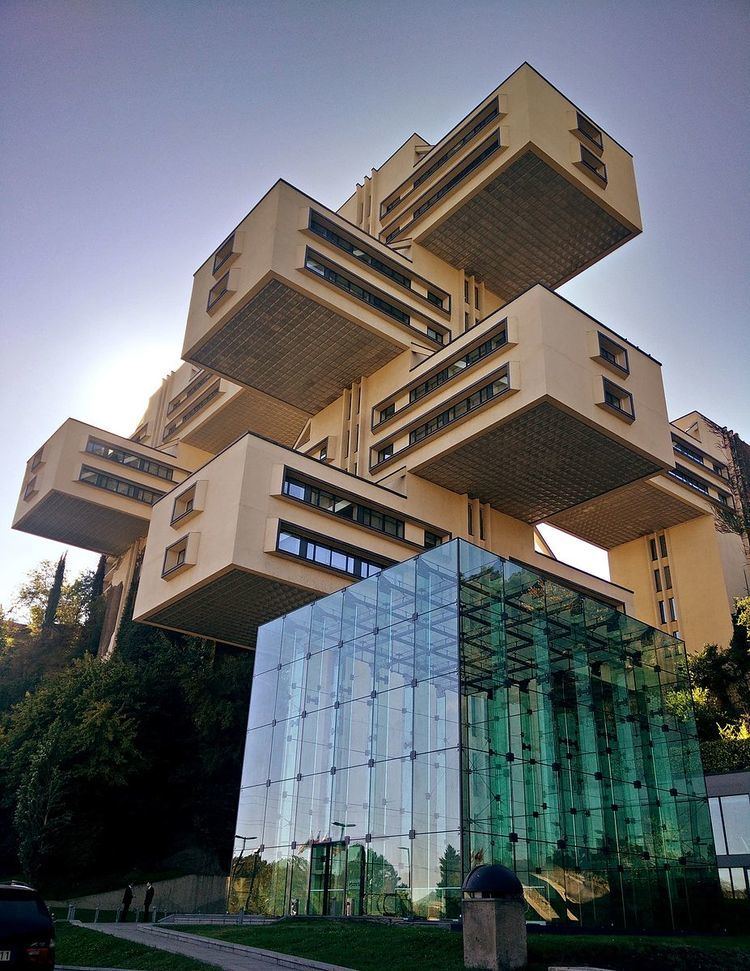
Ministry of Internal Affairs. In the NM “Modern Architecture Buildings” series, this large white limestone building is 7-stories with foyers in the front. It cannot be visited.
The Building of the Prosecutor’s Office. In the NM “Modern Architecture Buildings”, this is a large, rectangular yellow limestone building with no distinguishing features. Next door is the Ministry of Justice building, a double 12-story black glass skyscraper joined in the middle by a white glass segment.
TBILISI HISTORIC DISTRICT (24/10/2007)
Beside the river are the large brick domed King Erekle’s Baths.
Jumah Mosque. Accessed by a confusing maze of stairs that climb up towards the citadel, this is a wonderful old brick building with a multisided brick minaret. Inside there is no dome but flat ceilings painted with simple Islamic motifs and maqarnas decoration on the beams. There are two mihrabs and a narrow wood minbar. Large gothic windows provide wide views. A large ceramic heater is in the back.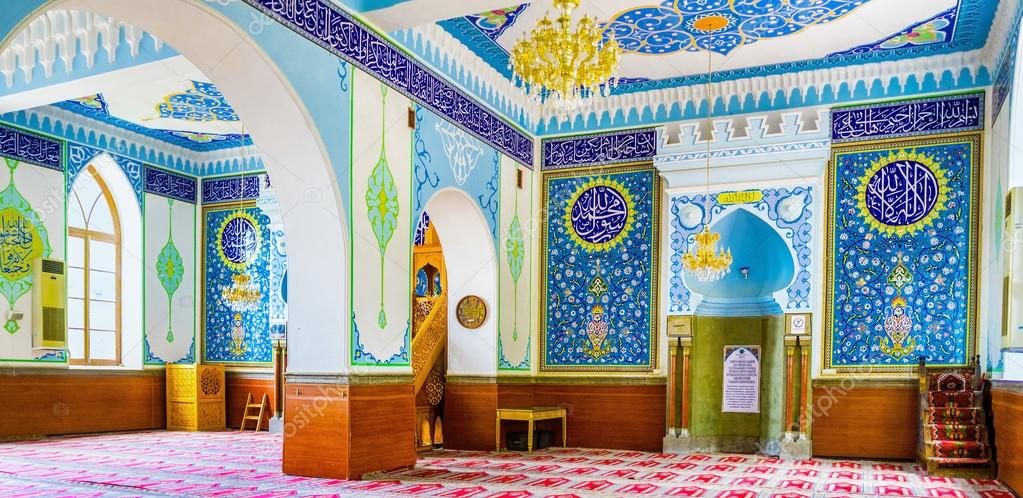
National Botanical Garden of Georgia. Just above the mosque and on the slopes below the fort, this nice garden has mostly large trees and bushes with no flowers at this time of the year. GEL5
Narikala Fortress. This medieval fortress sits above Old Tbilisi. It is simply ruined walls.
State Museum of Georgian Folk Songs and Instruments. Many instruments including bagpipes, accordions and mechanical players. Takes a special tour to hear the music. I counted 8 staff, probably more than they get visitors in a day. Opens at 11. GEL 3
Kartlis Deda. This is a massive statue of a woman in historic Georgian dress on the hill above old Tbilisi just north of the fortress. The views from here are some of the best in the city. The Mother of Georgia is a symbol of Tbilisi – the housewife ready to take a sword in her hand and do battle against enemies along side her husband and sons. Accessed by road.

Museum of Illusions. Many clever pictures, mirrors and puzzles, all a lot of fun, but explanations were needed to get the most from them. GEL 13
Great Synagogue of Tbilisi. Built in 1904-11 by Akhaltsekhi Jews, it is in a grand 3-story brick building with a menorah on the gable. Photos of the inside are in the David Baazov Musuem. It was uncertain if it was ever open to the public. No hours are posted but a man with no English indicated 5pm. Photographs of the interior are in the below museum showing a gallery and 3 sections of pews.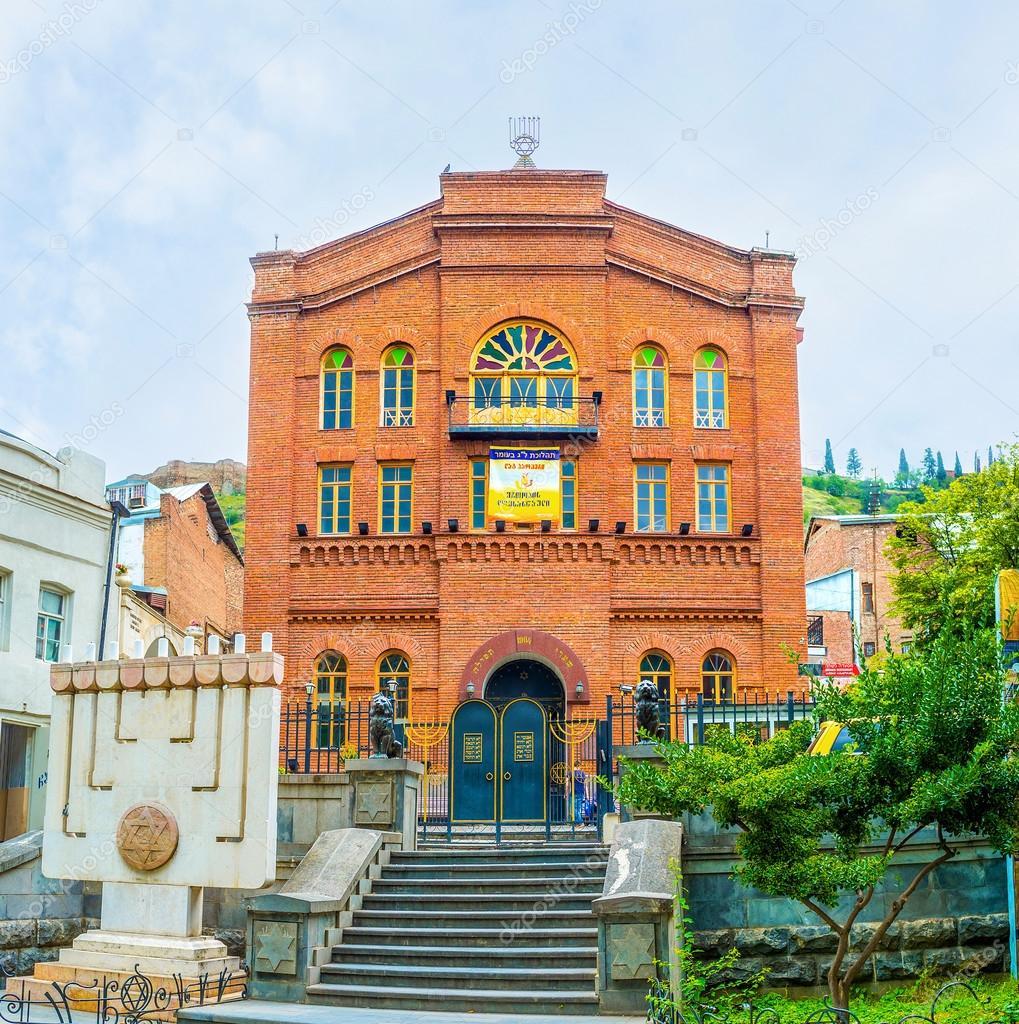

David Baazov Museum of History of the Jews of Georgia. There has been a centuries old peaceful relationship between Georgia and Jews. They have a common historical and cultural area as Jews arrived in the 8th century BC, after 586 BC, 2nd century BC to the 1st century AD, 6th-7th centuries, the 10th century and 19th -20th century. After King Nebuchadnezzar invaded Jerusalem, the Hebrews came to Kartli and then Mtskheta. When Vespasian destroyed Jerusalem, they also came to Mtskheta.
There has apparently never been anti-Semitism in Georgia, The Georgian Bagrationis kings were descendants of the Jewish kings David-Solomon and Joseph. Georgians were involved in saving Jews from Russian pogroms at the beginning of the 20th century and in WWII.
The museum is supposed to show the above but really didn’t. It is more an ethnography museum with religious pieces, books, art, costumes and Torahs all displayed in glass cases in the large circular room. GEL 5
Tbilisi History Museum. In an old caravanserai, it is really an ethnography museum – recreated shops, clothing, glass, weapons, rugs, furniture, many nice scale models, photographs and art displaying Tbilisi. Upstairs they were setting up a modern art exposition, downstairs are shops. GEL 2 to use the bathroom. GEL 5
Tbilisi Puppet Museum (Rezo Gabriadze Marionette Theatre). This renowned theatre puts on regular shows that are often sold out. The present production was “Autumn of My Spring” with subtitles in English. It was very entertaining. GEL 50
The outside of the theatre has a fantastic clock tower, all crooked and embellished with oddities.

Nikoloz Baratashvili House Museum. Baratashvili (1817-45) was a romantic Georgian poet who achieved great fame even though he died at age 27 (from injuries in Azerbaijan). He lived in this house from 1841-45. Nothing is original from his life but the furnishings are from the period. The exhibits employ many holograms to try to bring him to life. There are editions of his poetry but no English translations. GEL 5, 1 reduced
National Museum Pass. For GEL 20, see all the 4 national museums saving 50%.
Dry Bridge Flea Market. Next to the river in a park and fronted by a busy road, this was all the junk of poor Georgians.
Giorgi Leonidze State Museum of Literature. Only irregular exhibits are displayed in the main hall. When I was there, a local photographer had a great display of black and white photography on the indigenous Muslim people in the remote Ajara highlands of Georgia. They have an agrarian economy.
Experimentorium. Dubbed the Museum of Entertaining Science, this was a mass of yelling children having fun with all the exhibits orientated to children. Not so much interest to adults. GEL 14
Georgian Museum of Fine Arts. This modern art museum was exclusively Georgian artists, most that I didn’t enjoy much, except the following: on the 3rd floor – Tato Akhal Katsishidi, Oleg Timchenko and Sheiba Matushveli; 4th floor – Dmiti Eristavi with many erotic bronzes and Eduard Shakhnazarov. The highlight though is the marvelous transportation column in the center – all plate glass stairs. GEL 15 Georgian National Museum. The major temporary exhibit was mosaics from the Capitoline of Rome. Archaeology from the initial occupation of Georgia 1.77 million years ago showed many skulls and progressed through the Stone Age through to the Byzantines. A natural history section shows minerals and crystals and many stuffed animals. Ethnography and religious art (Gelati Monastery) occupies one floor.
The highlight is the treasury with 600 gold works from the 3rd millennium especially highlighting the Colchian Culture (5th-3rd centuries BC) and the Karti culture from the 3rd century and at its greatest in the 1st-3rd centuries AD at Armaztaikhe. GEL 15
Museum of the Soviet Occupation. Occupying half the 4th floor of the Georgian National Museum, this told the grim 70-year story of Soviet occupation of Georgia from 1921-91. Georgia declared its independence in May 26, 1818, signed a treaty with Russia in 1920 and was invaded in February 1921. Massive repressions followed with the extermination of the elite of Georgian society, the aristocracy, clergy, intelligentsia and rich peasants. In 1937-38, all those who had survived from the 20s were summarily executed. Between 1921-41, 72,000 were shot and 200,000 deported from a population of 4 million. From 1942-52, another 5000 were shot and 190,000 deported – and all by Stalin (died in 1953), a native Georgian from Gori. Resistance was common but dealt with harshly. The displays are mostly in Georgian and a little disorganized. Rallies started in 1987 and in April 1991, 98% of Georgians voted for independence in a referendum.
Mose Toidze House-Museum. Mose Toidze (1871-1953) was a Georgian painter, graphic, academician and professor of the Tbilisi Academy of Arts. In 1896 he left Tbilisi for St. Petersburg to begin his artistic study. In 1922, he founded Tbilisi Public Art Studio and headed the Studio until 1930. He was active in revolutionary and education activities promoting democracy. His paintings reflect the bright scenes of everyday life of the Georgian people, later works show the socialist construction and the events of the Great Patriotic War. He was awarded the Lenin medal and the Badge of Honor medal.
The museum was opened in Toidze’s apartment in Tbilisi in 1968. Since 2005, it is part of the Georgian National Museum Complex with more than 2000 paintings and graphics of the artist, photos (including writers; movie and theater actors’) and documentary materials (his personal letters and publications), as well as works of his son – painter Irakli Toidze, Valentin Krotkov, Eugene Kibrik, Boris Phogel and Khalilbek Musayev.
Day 2 in Tbilisi
It had been raining for a day and the surrounding mountains were dusted in snow. Museum of Ethnography (Open Air Museum of Ethnography). In the hills west of the city, this large 52-hectare open-air museum has 11 regional areas with 70 buildings, but most of the houses were not open. Fortunately an employee with excellent English (he is the artist and a guide for the museum) showed me most of the interesting buildings. Everything here was moved from elsewhere and reconstructed on site. The highlights are two underground houses both with wonderful central chimneys/sky lights constructed of overlapping wood wide at the base and narrowing to form cones. One was a fantastic 12-sided construction of 452 pieces. 
Most of the other buildings are plank built, high ceiling structures full of household items. Some of the more interesting were a 2nd millennium dolmen, a large collection of historical tombstones (carved with the occupations of the interred), a wine house and ethnography house.

There were a group of 7 men drinking homemade grappa and barbequing near the entrance of the museum. I joined them and had some grappa and an excellent meat sandwich. They were a friendly, generous, jovial, if more than a little drunk, group. GEL5
Tbilisi Funicular Railway. More bad information from Google Maps. It directed me to a road and stairs that eventually, after a long climb, accessed the middle station of the funicular. If you want to go this way, DON’T drive up the last 4 tight switchbacks to the monastery, but park at the large lot just before them, walk up the road, then stairs.
I went back and found the true beginning of the funicular. It climbs to a restaurant and Matsminda Park with the Tbilisi TV tower for the best views of Tbilisi. GEL 3 each way, a great value as it climbs to the top of the mountain.
Art Museum of Georgia. Unfortunately, it was closed for renovation but some of the significant art was in the National Museum.
Bridge of Peace. Built in 2010, this 150m long, bow-shaped pedestrian bridge over the Kura River connects Old Tbilisi with the new district. It has a curvy, sea-colored glass roof, giving the whole structure a unique fishnet look that shimmers with an interactive light display at night, generated by 6,040 high-power custom white LEDs.
There are four different lighting programs that run on the canopy every hour. At times, the bridge lights up in waves from one side of the river to the other. At other times, the pattern begins with a band of light at either end, continuing from either direction until the light meets in the middle, and fading to black before starting over. The third program starts by lighting the outer fixtures on the roofline, then briefly illuminates the entire canopy before going entirely dark. The fourth program makes the roof twinkle like stars as different groups of fixtures light and dim across the entire bridge length.
The handrail glass panels that run along the whole length of the walkway are equipped with embedded linear low-power LED arrays, a product called powerglass, supplied by Glas-Platz from Germany. Within the bridge walkway, the low-power linear LED arrays embedded in the glass railings are triggered by 240 motion sensors as the pedestrians pass, giving an impression that the bridge lights come on for each person setting foot on the bridge. Additionally, a message in Morse code that renders the periodic table of elements goes across two parapets every hour. The lights designer considers this communication celebration of “life and peace between people”. The lighting is switched on 90 minutes before sunset.
The structure of the bridge was built in Italy and transported to Tbilisi in 200 trucks while the lighting was installed on site during the assembly of the structures.  Holy Trinity Cathedral. This new Georgian Orthodox cathedral is on top of the hill on the east side of the river from Old Tbilisi. Enter a yellow stone grand gate and wall and walk up the monumental marble walk past many carved stone pillars. The architecture is dramatic from the outside, crescending gabled buildings rising to the gold coned dome. Inside it has 3 naves and a balcony, marble wainscoting and columns but is otherwise all plain grey. There are many wood framed icons, none matching so must have come from the original church. The oldest are collected into two great wood frames. The apse is painted with frescoes. Free
Holy Trinity Cathedral. This new Georgian Orthodox cathedral is on top of the hill on the east side of the river from Old Tbilisi. Enter a yellow stone grand gate and wall and walk up the monumental marble walk past many carved stone pillars. The architecture is dramatic from the outside, crescending gabled buildings rising to the gold coned dome. Inside it has 3 naves and a balcony, marble wainscoting and columns but is otherwise all plain grey. There are many wood framed icons, none matching so must have come from the original church. The oldest are collected into two great wood frames. The apse is painted with frescoes. Free
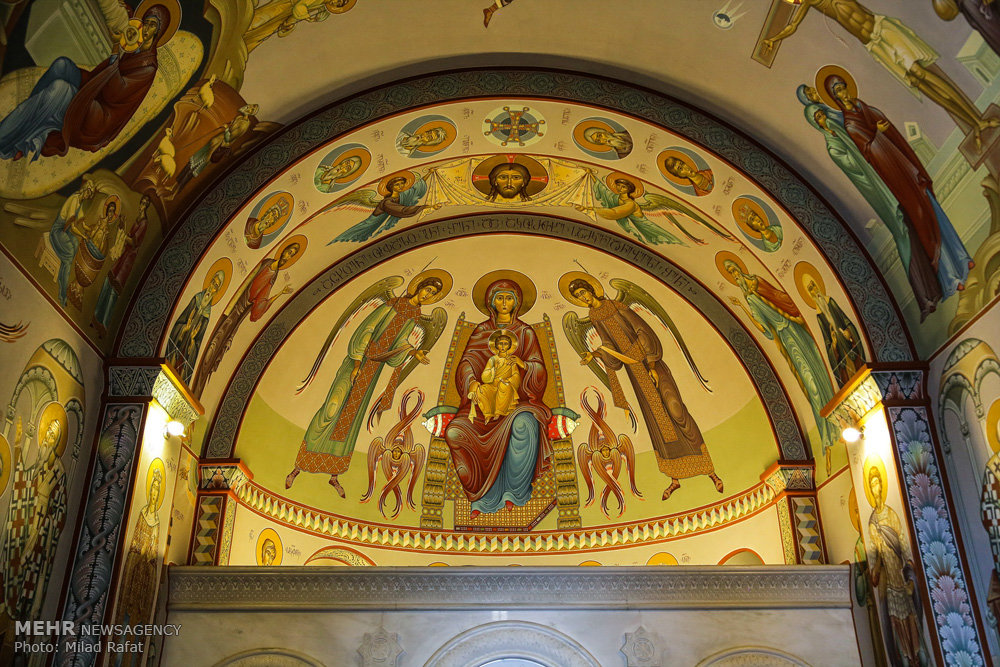 Georgian Museum of Theatre, Music, Cinema and Choreography (Art Palace). Mostly art from the 1950s in some of the lower rooms (I enjoyed Bruno Vepkhirdze), then a mixture of art, furniture and a wonderful decorative ceramic stove. It was a confusing building to navigate and I never did find the theatre, music or dance exhibits. GEL 10
Georgian Museum of Theatre, Music, Cinema and Choreography (Art Palace). Mostly art from the 1950s in some of the lower rooms (I enjoyed Bruno Vepkhirdze), then a mixture of art, furniture and a wonderful decorative ceramic stove. It was a confusing building to navigate and I never did find the theatre, music or dance exhibits. GEL 10
Dezerter Bazaar. This is a real hodge-podge of covered outdoor vegetable stalls, spices and fish, then inside shoes, and then clothes in completely crowded displays. Quite an old-fashioned market, but I found some cheap sunglasses.
Silk Museum. Housed in a purpose built grand 2-story building from 1887-90, the collection and dated displays are from the same period. Some cards with English explained the process (boiling the cocoons in soapy water to dissolve the glue-like sericin leaving only the fiboin protein), some thread producing machines, Jacquard weaving, the white mulberry tree etc, but all labels were in Georgian. There is a collection of 5000 cocoons from all the major silk producing nations and many examples of cloth, silk flowers and silk lace. It needs updating with better labeling. There is an incongruous seashell exhibit on the lower floor. GEL 5
Elene Akhvlediani Memorial Museum. Elene Akhvlediani (1901-76) was one of the first recognized female painters in Georgia. Her usual subject was Old Tbilisi and Georgian architects used her works for the reconstruction of some of the city’s old buildings. She illustrated the works of the Georgian writers Ilia Chavchavadze and Vazha-Pshavela, and designed for plays in the Marjanishvili Theater. She was also an organizer of a female painters group. Her paintings were showcased in Paris.
In 1971, she became the first painter to be awarded The Shota Rustaveli State Prize, the highest prize awarded by Georgia in the fields of art and literature. GEL5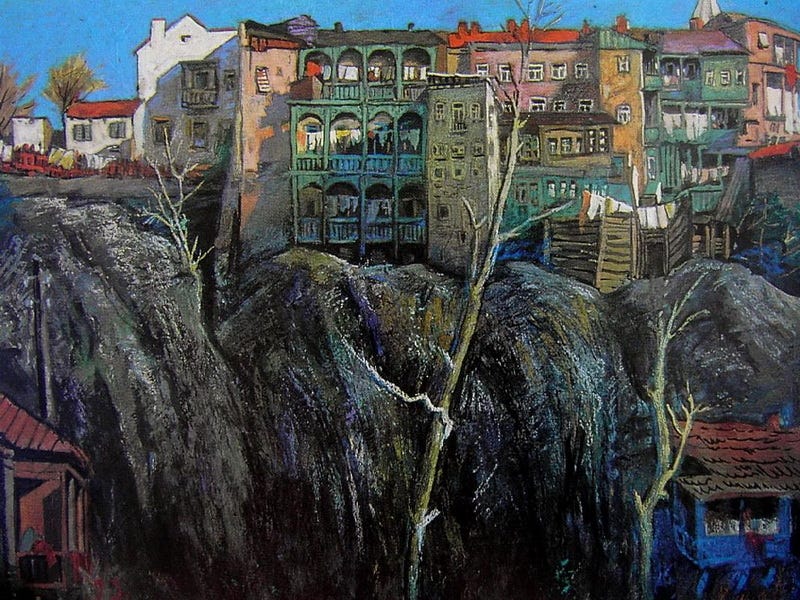

Merab Kostava Memorial House-Museum. Merab Kostava (1939-89) was a Georgian dissident, musician and poet and one of the leaders of the National-Liberation movement in Georgia. Along with Zviad Gamsakhurdia, he led the dissident movement in Georgia against the Soviet Union, until his death in a car accident in 1989. Kostava was born in 1939 in Tbilisi. From 1962–1977 he was a teacher at a local music school in Tbilisi.
In 1954, Kostava and Zviad Gamsakhurdia founded the Georgian youth underground organization “Gorgasliani,” a tribute to Vakhtang Gorgasali, the medieval Georgian king who supposedly founded the capital, Tbilisi. Between 1956 and 1958 Kostava, together with Gamsakhurdia and several other members of this organization were jailed by the KGB for “anti-Soviet activity.” for the dissemination of anti-communist literature and proclamations.
In 1973, Kostava and Gamsakhurdia established the Initiative Group for defense of Human Rights. In 1976, he co-founded the Georgian Helsinki Group. After 1975 Kostava was a member of Amnesty International.
In 1977, Kostava and Gamsakhurdia were arrested and jailed, charged with spreading anti-Soviet propaganda relating to the pillaging of church artifacts and the deportation of subsequent treatment of the Meskhetian Turks. Kostava was sent to Siberia to serve his sentence. While Gamsakhurdia publicly renounced his views in hopes of a lesser sentence, Kostava refused to do so. He was released from prison in August, 1987. In 1978, the two men were nominated to the Nobel Peace Prize by the Congress of the USA. From 1988–1989 he was one of the organizers and active participants of most (if not all) peaceful pro-independence political actions within the Georgian SSR, in April, 1989, he was jailed again but was released after 45 days.
Merab Kostava was active in the underground network of Samizdat publishers, co-publisher of the Georgian underground periodical “Okros Satsmisi” (“The Golden Fleece”). He was the author of many important literary and scientific works.
In 2013, he was posthumously awarded the title and Order of National Hero of Georgia. There are streets named after him in Tbilisi, Batumi, and Shindisi. GEL5
Zakaria Paliashvili Memorial House-Museum. Zakaria Paliashvili (1871-1933) was a Georgian composer. Regarded as one of the founders of the Georgian classical music, his work is known for its eclectic fusion of folk songs and stories with 19th-century Romantic classical themes. He was the founder of the Georgian Philharmonic Society and later, the head of the Tbilisi State Conservatoire. The Georgian National Opera and Ballet Theater of Tbilisi was named in his honor in 1937. Notably, Paliashvili’s music serves as the basis of the National Anthem of Georgia.
Although Paliashvili has composed works for symphony orchestra (e.g., Georgian Suite on Folk Themes), he is probably best known for his vocal music, which includes operas Abesalom da Eteri (based on a folk tale “Eteriani”), Daisi (Twilight), and Latavra. GEL5
Georgian National Centre of Manuscripts. I only went here to give me a Nomad Mania tick – it was completely irrelevant and most in Georgian. GEL 5
Georgian Technical University. In the NM “Modern Architecture Buildings” series, this is a grand building with a lobby topped by a great round “ballroom”. Behind is a long 5-story rectangle.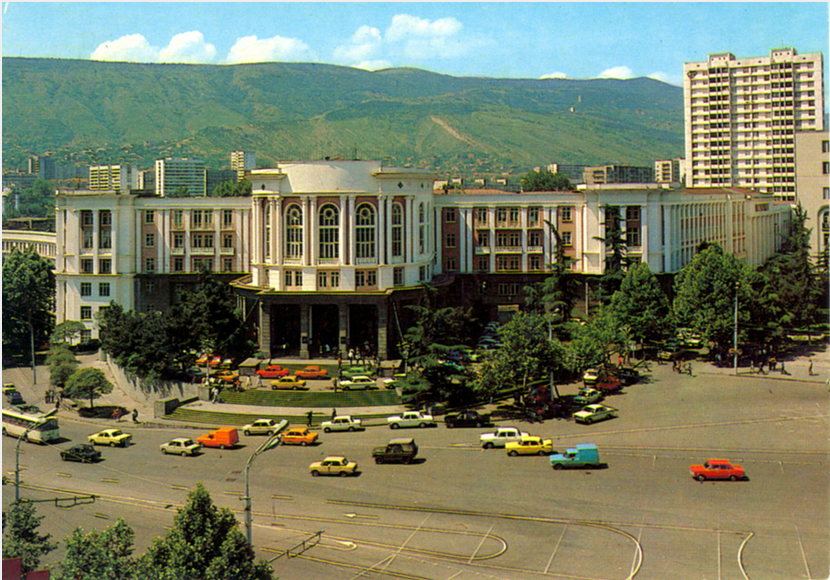
I often sleep near a McDonalds as they are common everywhere and the only dependable source of wifi that I need almost daily as I don’t usually SIM my phone in every country. It is amazing how popular they are. In Tbilisi I stayed next to one of the largest McDonalds I have ever seen with two stories. At 10pm, I counted 22 cars in the McDrive and the inside was crowded. Every country has an individual menu. and ordering is from many stand up screens. Table service is offered. The food is just as bad, more expensive than in Canada and I rarely eat at them.
I slept for my third night in Tbilisi and left early in the morning for the rest of the eastern part of Georgia on my way to Azerbaijan.
I then made a questionable decision. In my quest to see every possible World Heritage Site and as many Tentative WHSs as possible, I took a swing to the northeast in the mountains to see the following tentative sites.
Ananuri. A tentative WHS (24/10/2007), this is a castle complex on the Aragvi River in Georgia, about 45 miles (72 kilometres) from Tbilisi.
Ananuri was a castle and seat of the eristavis (Dukes) of Aragvi, a feudal dynasty which ruled the area from the 13th century. The castle was the scene of numerous battles.
In 1739, Ananuri was attacked by forces from a rival duchy, commanded by Shanshe of Ksani and was set on fire. The Aragvi clan was massacred. However, four years later, the local peasants revolted against rule by the Shamshe, killing the usurpers and inviting King Teimuraz II to rule directly over them. However, in 1746, King Teimuraz was forced to suppress another peasant uprising, with the help of King Erekle II of Kakheti. The fortress remained in use until the beginning of the 19th century.
The fortifications consist of two castles joined by a crenellated curtain wall. The upper fortification with a large square tower, known as Sheupovari, is well preserved and is the location of the last defense of the Aragvi against the Shanshe. The lower fortification, with a round tower, is mostly in ruins.
Within the complex, amongst other buildings, are two churches. The older Church of the Virgin, which abuts a tall square tower, has the graves of some of the Dukes of Aragvi. It dates from the first half of the 17th century, and was built of brick. The interior is no longer decorated, but of interest is a stone baldaquin erected by the widow of the Duke Edishera, who died in 1674.
The larger Church of the Mother of God (Ghvtismshobeli), built in 1689 for the son of Duke Bardzim. It is a central dome style structure with richly decorated façades, including a carved north entrance and a carved grapevine cross on the south façade. It also contains the remains of a number of frescoes, most of which were destroyed by the fire in the 18th century.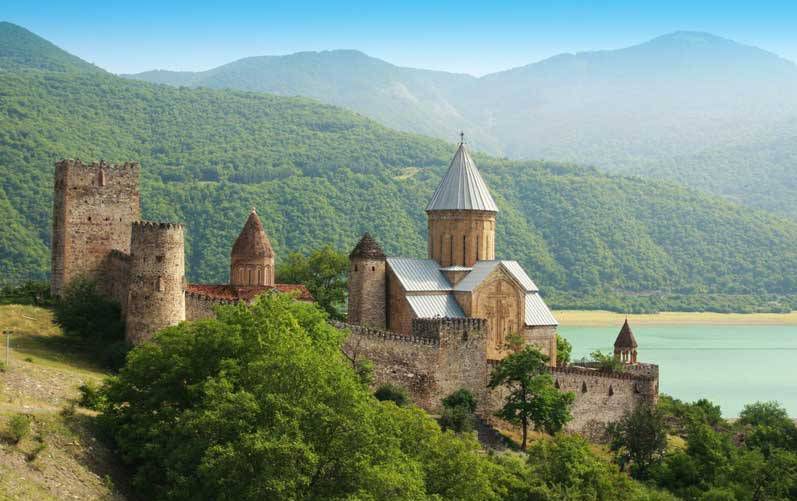
It wasn’t long before I hit winter with very slick roads – a thin veneer of snow, some deeper snow, rain, -2.5°C – and very slow driving. But other vehicles were coming my way so I decided to continue. The snow got deeper, the road punctuated by long stretches of gravel alternating with pavement until I finally hit a pass and started the descent.
Kvetera Fortress Church. Tentative WHS (24/10/2007). A Georgian Orthodox church in the historic fortified town of Kvetera in Kakheti, it was built in the early part of the 10th century. It is a relatively small church and resembles the Georgian cross-dome style of architecture. The dome rests on a round tympanum and rises over the central square pace. The facade has symmetrical arches but few ornaments that is typical for Kakhetian churches. Kvetera dates back at least to 8th century AD.
On a 1km side road covered with snow, I walked the 15 minutes to see this site. Of course it was not open. 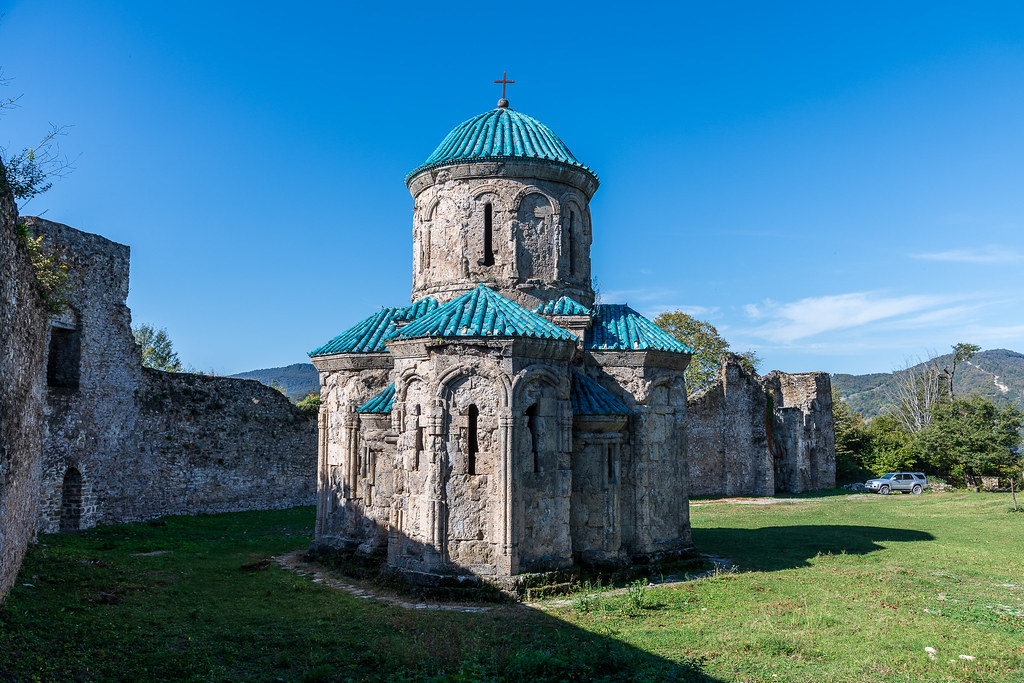

The main road slowly descended out of the snow but the temperature hovered around 0-2°C.
Alaverdi Cathedral (24/10/2007). A monastery renowned for its wine, it is entirely fortified with a 8 meter wall and towers. The 3-nave church is built on a square cross design with a tremendously high dome. Once covered with frescoes, only a few very faded ones remain. The best may be at te top of the apse. The highlight may be all the lovely carved wood stands each holding an icon.
The yard outside has 104 varieties of old Georgian grape vines. 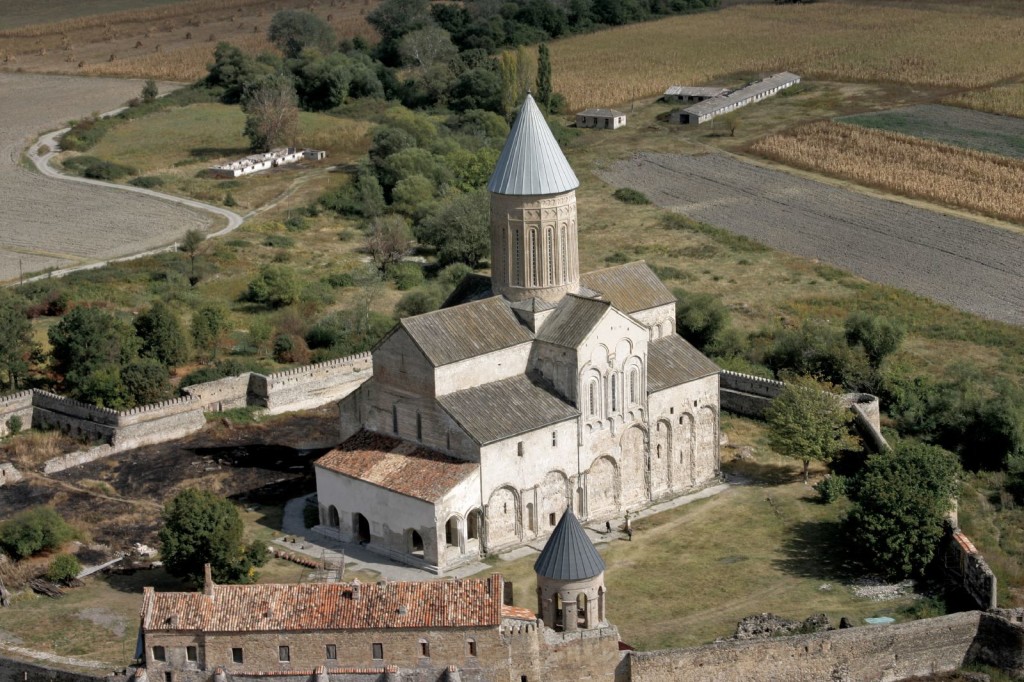
This is Georgian wine country on “The Wine Route” with many cellars, vineyards and a few wine shops. But the vineyards don’t cover absolutely everything. Every house seems surrounded by trellises of vines.
Gremi Church of Archangels and Royal Tower (24/10/2007). Sitting on top of a small pimple of a rock, it is fortified with short walls. The tiny church is a true square cross with one central pair of columns. It was completely frescoed at one time but now are in a sorry shape, parts completely absent but some still intact. Each scene has a red border and a preponderance of blue backgrounds.
The museum is in the tower. It tells the story of the local kings. Gremi was the royal capital of Kakheti from 1466-1616. The church dates from 1565. King Leon liberated Jerusalem, the tomb of Christ and Golgotha in 1517, renovating them in 1533-37. He was a wise and flexible ruler.
Take the stairs to the right to a domed room with agricultural tools. The stairs to the left go to the top with an empty vaulted room.
Nekresi Monastery, Kvareli. It is not possible to drive up, so walk or park at the bottom and either pay the GEL 20 or wait for a load of 10 passengers (GEL2/person) to take you the 1.5kms up the steep road to the monastery. It was at the snow line.
The tiny church has a small narthex with few gilt back icons. A corridor on the left side has a box of bones of monks buried here and the one on the right, an icon. The nave has a round vaulted roof and is very dim inside with a narrow slit window in the apse and one small window on one wall. The north wall and apse have mostly vanished murals, but they are better on the south and back walls. Unusually the iconoclast is made of wide stone.
The monks quarters has a tower, 2-story building with a basement and a kitchen with 10 openings for storing wine and wheat. A huge trough was for making wine. A plaque dates the small chapel below to the 8th-9th century.
The main reason to come here are the expansive views – mountains to the north and huge views down to the plains in the south and east. 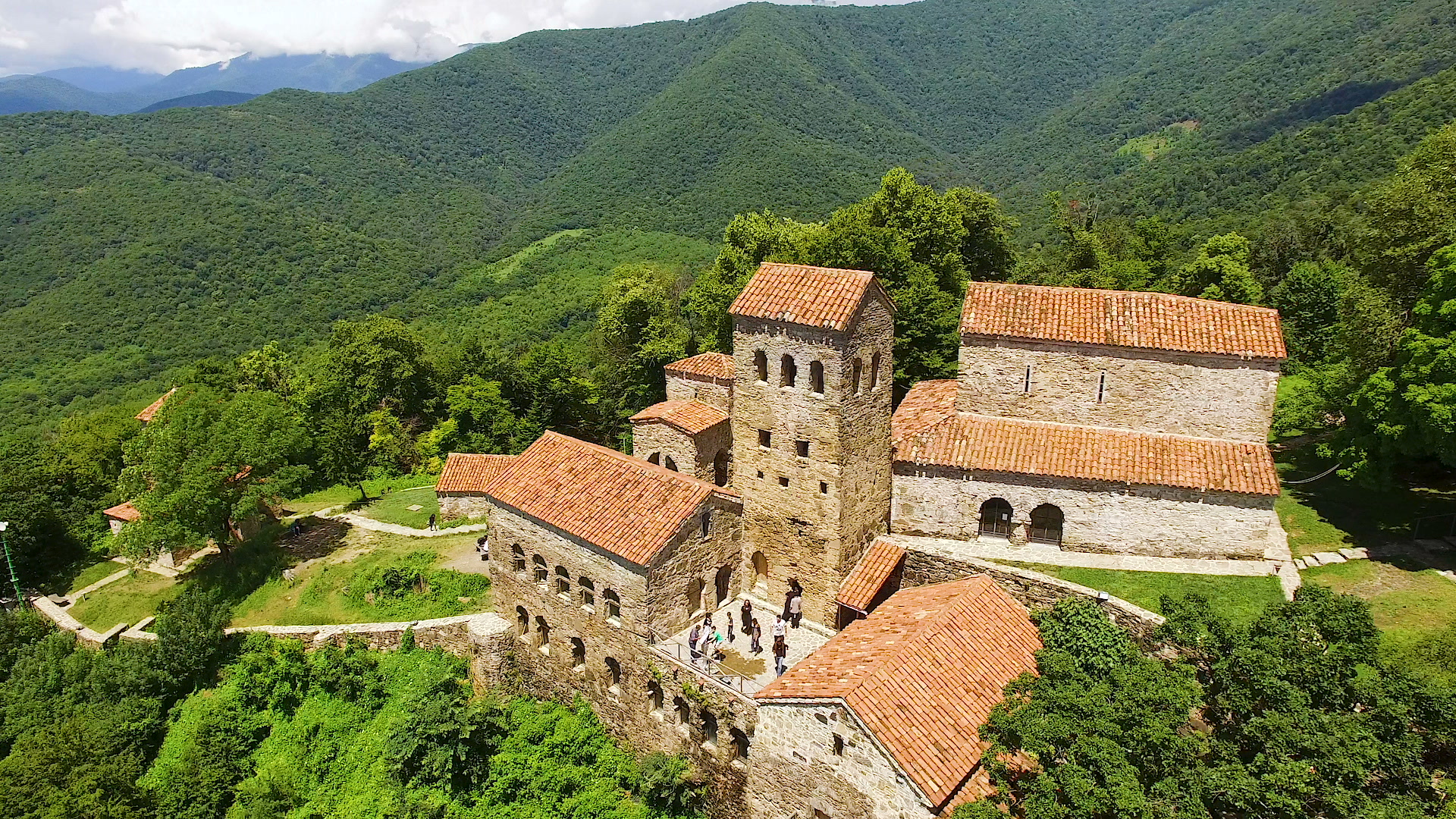
On November 28th, I returned to Tbilisi. This was not my plan but I needed to replace my brake pads! I was told 16,000 kilometers ago in Germany that I needed new pads in order to prevent damaging the discs. But I kept putting it off and finding a garage always seemed impossible. I happened to pass one in west Azerbaijan who said there was only about 500kms left on my pads, but he didn’t have the correct ones. I phoned the VW dealer in Tbilisi who also had none and they would take 3 weeks to deliver but he would look for aftermarket pads. So I belatedly returned to Tbilisi and they had the pads in stock and amazingly fit me right in and changed them!!
I hate Georgian drivers – they are impatient and the types who accelerate hard and brake hard so there is always someone racing beside you. Changing lanes is a test.
Having a vehicle in top shape is crucial to my travel. I can now continue my travels and will enter Armenia tomorrow.
GO TO Armenia – North
I returned to southwest Georgia from northwest Armenia on December 4, 2019. The roads were terrible with lots of potholes plus there was packed snow and temperatures of -2°C.
15kms north of the border, I passed through the village of Gorelovka, the main village of the Doukhobors (read my post about these pacifist Russians who emigrated to Canada. 7,400 boarded ships in 1898-99 from Batumi, Geogia). My Doukhobor friend from home said that a few locals had come here to see it but had been disappointed. It was tiny and full of old dilapidated houses – not very inspiring. There is almost no Doukhobor community here now.
Even though I was only driving through 75kms of Georgia to get to Turkey, I bought the compulsory vehicle insurance (GEL 30 for 15 days) and I was asked for proof of it at immigration when I left. The roads continued with lots of potholes – the dangerous kind with stretches of good pavement then all of a sudden a minefield. Even though it was dark, it was snowing lightly and I thought things would not be better in the morning so continued. The road had a slick surface of thin compact snow and large trucks immediately tractioned out on any incline. One was skewered ¾ of the way across the road and one was in the ditch on the opposite side of the road. I drove slowly and made it to the Georgia/Turkey border. Georgia was the first country I have ever traveled to that had a record of my parking tickets and I had to pay them before I left (GEL 60 or US$22).
Turkish border immigration was the usual bureaucratic nightmare. They checked the same documents three times. I had a long wait while one of them had dinner. Interestingly, there was no record of my having entered Turkey (read about how I was defrauded at the Bulgaria/Turkey border in October and not given passport stamps for my €50 – and thus not registered as having entered). I tried to explain but English communication was not good.
Tusheti Road. I didn’t go here but include it for interest sake.
Located at 5,413 -14,740 feet above sea level, Tusheti is a region in northeast Georgia. It captivates by beauty, but as it is positioned on the northern slopes of the Caucasus mountains, getting there is quite challenging.
Tusheti is divided by four gorges: Pirikiti, Gometseri, Chagma and Chanchakhovani. The road to Tusheti is considered as one of the most dangerous roads in the world. The road lays on slopes and goes up to 9842 feet over gorges of Tusheti.
The largest village and a center of Tusheti is Omalo. The only access road to it is through the Abano pass (9,350 ft). From Omalo there are three different directions along with mountain ranges. Chanchakhovani gorge is the entrance to Tusheti. Others are: Diklo-Shenako gorge and Pirikiti and Gometzari gorges. Each road parts after a few kilometers. All directions are vehicle accessible, but further and higher the road goes, more difficult and worse it gets. Alpine climate, fog, mist and low visibility, make the road even more hazardous.
On the other hand, there are plenty of trails and trekking options. Though, it takes longer to walk from a point A to point B, at least there is no risk involved.

NOMAD MANIA Georgia – Kartli Shida/Kvemo, Mtskheta, Kakheti (Tbilisi, Gori)
World Heritage Sites: Historical Monuments of Mtskheta
Tentative WHS
Alaverdi Cathedral (24/10/2007)
Ananuri (24/10/2007)
David Gareji Monasteries and Hermitage (24/10/2007)
Gremi Church of Archangels and Royal Tower (24/10/2007)
Kvetera Church (24/10/2007)
Mta-Tusheti (24/10/2007)
Samtavisi Cathedral (24/10/2007)
Shatili (24/10/2007)
Tbilisi Historic District (24/10/2007)
Uplistsikhe Cave Town (24/10/2007)
Sights: Bodbe Monastery
Borders
Armenia-Georgia
Azerbaijan-Georgia
Georgia-Russia
XL
Extreme East border with Azerbaijan (Dedoplistqaro)
Kazbegi (Stepantsminda)
Southeastern desert areas on the border with Azerbaijan (David Gareja)
House Museums/Plantations: Tsinandali: Chavchavadze House Museum|Castles, Palaces, Forts
Mukhrani: Palace of Mukhrani (Chateau Mukhrani Winery)
Omalo: Keselo Fortress
Religious Temples
Akhmeta: Alaverdi St. George Cathedral
Kvareli: Nekresi Monastery
Oni: Gergeti Trinity Church (Sight Kazbegi-Trinity Monastery)
World of Nature
Algeti (great ruins)
Tusheti
Vashlovani
Festivals
Alaverdoba
Berikaoba
Experiences:
Attend Georgian ‘Supra’
Drive on Tusheti road
Tamaroba
Taste Khachapuri
Entertainment/Things to do: Uplistsikhe Cave Town
Caves; Uplistsikhe Caves
Ski Resorts: Gudauri
MTSKHETA
World Heritage Site: Historical Monuments of Mtskheta.
Religious Temples: Svetitskhoveli Cathedral.
Museums: Mtskheta Museum
Cities of Asia and Oceania
GORI
House Museums/Plantations: Stalin House and Museum
Castles, Palaces, Forts: Gori Fortress
RUSTAVI
Museums: Rustavi History Museum
TBILISI World Capital, World City and Popular Town
Airports: Tbilisi (TBS)
Railway, Metro, Funiculars, Cable Cars: Tbilisi Funicular Railway, Tbilisi Metro
Museums
Art Museum of Georgia
David Baazov Museum of History of the Jews of Georgia
Georgian Museum of Theatre, Music, Cinema and Choreography (Art Palace)
Georgian Museum of Fine Arts
Georgian National Centre of Manuscripts
Georgian National Museum
Giorgi Leonidze State Museum of Literature
Museum of Ethnography (Open Air Museum of Ethnography)
Museum of illusions
Silk Museum
State museum of Georgian folk Songs and Instruments
Tbilisi History Museum
Tbilisi Puppet Museum (Rezo Gabriadze Marionette Theatre)
House Museums/Plantations
Elene Akhvlediani Memorial Museum
Merab Kostava Memorial House-Museum
Mose Toidze House-Museum
Nikoloz Baratashvili House Museum
Zakaria Paliashvili Memorial House-Museum
Religious Temples
Great Synagogue of Tbilisi
Holy Trinity Cathedral (Sight)
Jumah mosque
Modern Architecture Buildings
Bank of Georgia Headquarters
Georgian Technical University
House of Justice
Music Hall (Bablio Music Hall)
The building of the Prosecutor’s Office
Ministry of Internal Affairs
Entertainment/Things to do: Experimentorium
Zoos: Tbilisi Zoo
Botanical Gardens: National Botanical Garden of Georgia
Markets
Dezerter Bazaar
Dry Bridge Flea Market
Monuments: Kartlis Deda
Pedestrian Bridges: Bridge of Peace
Open-Air Museums: Tbilisi Open Air Museum of Ethnography
Vehicle Museums: Tbilisi Auto Museum
The Dark Side: Museum of the Soviet Occupation (Georgian National Museum)
Festivals
Tbilisi International Festival of Theatre
Chabukiani–Balanchine Festival
Tbilisi Open Air
Villages and Small Towns
DARTLO
SIGNAGI (Sight)
STEPANTSMINDA (Sight)
TELAVI
Sight: Kakheti Wineyards
Castles, Palaces, Forts: Batonis Tsikhe